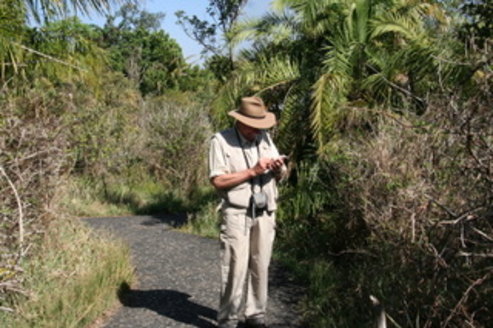
Upon matriculation, he obtained a traineeship from the Forestry Commission of NSW. This led to two years at Sydney University, a year working in forests and then the final two years at the Australian Forestry School in Canberra (now part of the ANU).
He won the Schlich Memorial Medal in 1952. Eventually, he returned to Sydney University where he gained first class honours in botany.

George Baur, in his element.
He married Ruth Moore in 1955 having met her when they both attended the Killara Congregational Church. Upon their marriage they went to live in Coffs Harbour where he worked in local forests. In 1957, he published an important statement on rainforests in NSW.
In 1960, he received an Andre Mayer FAO fellowship and so the family travelled to Rome, England, Washington and Puerto Rico. Baur travelled extensively in the Amazon during this stay and became significantly unwell from catching malaria. When he recovered, the family returned to Sydney while he went on to Nigeria, Malaya and elsewhere.
The Government Printer published his research into the ecological basis of rainforest silviculture. He was appointed head of research at the Forestry Commission during which time he introduced comprehensive guidelines on recording and reporting research data. Increasingly he was deeply involved in formulating and implementing the Forestry Commission’s environmental policies.
Baur wrote numerous scientific papers including in 1965 a seminal research note Forest Types of NSW that sought to classify vegetation type. Over many years, he wrote silvicultural notes and jottings that were anthologised by Forestry NSW. He was also possibly the first forester in Australia to write in 1972 a book for the layman called A Bit about the Bush.
He introduced everything from the term “dry rainforest” to scientific and conservational reserves (eventually amounting to over 32,000 hectares) within State Forests and the white on green State Forest signage. His experiments led to the “50 per cent canopy retention” with selective logging system in rainforests. He spearheaded a forester’s approach to conservation based on research, scientific impeccability, ecological integrity and a balanced approach of the competing demands on forest resources.
On the ground Baur confronted established thinking which was that rainforests were not inherently valuable and needed to firstly be logged of their most valuable species and then cleared, followed by conversion to farms or plantations of a single type of non-rainforest tree, usually pine.
This is a practice that is still common around the world and has recently been especially newsworthy in Brazil. Among other things it has been criticised for loss of diversity and contribution to climate change. As Baur said in 1957 “conversion is costly and the clearing of the sites leads to the destruction of useful, established regeneration and the sale of vigorous, small girth logs of valuable species at minimum royalties”. With much prescience he said, “conversion to plantation leads to the wasteful loss of much potentially valuable growing stock and is likely to be economically doubtful”.
He wanted the rainforests to be “brought under sustained yield management with a strong likelihood that by wise use of silvicultural techniques the proportion of first-class species in the stands can be greatly increased”. This brought him into conflict with both environmentalists who wanted remaining rainforests to be converted into national parks and remained untouched as well as governments who banked on the economic benefits of a single timber plantation.
Following six months in the school of forestry at the University of Christchurch in New Zealand, Baur was invited in 1981 by the Australian Forestry Council to prepare the forestry statement dealing with the then National Conservation Strategy. In 1984, he was awarded the N.W. Jolly Medal, the highest award of merit by the Institute of Foresters.
Baur’s first wife Ruth died in 1993 and he retired to care for her in her final illness. Some years later he married a long-standing family friend, Norma Bennetts. He was blessed with two happy marriages.
Apart from Norma he left two daughters, two grandsons and four great-grandchildren.
Louise Baur & Angela Bell









 Add Category
Add Category